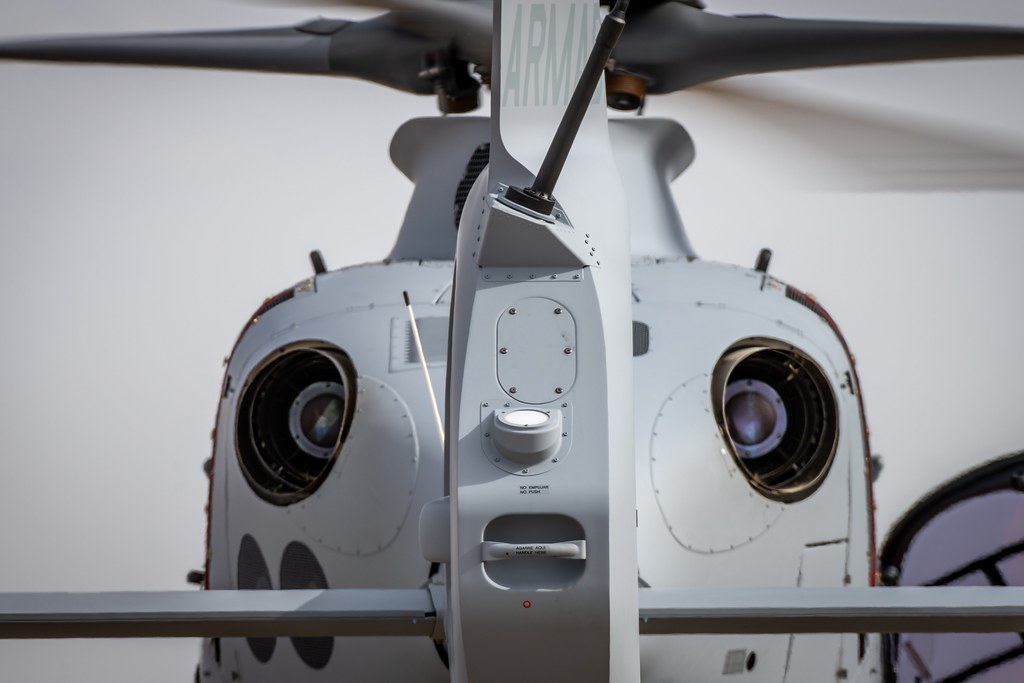The first Airbus H135 P3H Nival helicopter of the 12th Squadron of the Spanish Navy
This Thursday, October 26, the Spanish Navy has taken a new step to renew the air resources of its Aircraft Flotilla.
In February of this year it was known the creation of a new unit of the Aircraft Flotilla, the 12th Squadron, which has a snowy owl ("nival", in Spanish) as its emblem or great white owl, a bird that will give its name to its radio callsign, "Nival", and also, as is tradition in the Air Arm of the Spanish Navy, to the new helicopters of this unit: the Airbus H135 (model formerly known as EC-135), specifically the P3H variant, with more powerful engines (it is equipped with two 492 kW engines) and a greater maximum takeoff weight (2,980 kg) than the versions initials.

The new unit will be aimed mainly at training aviators, hence its motto is "Disce et vola" (Learn and fly, in Latin). Both the 12th Squadron and the new H135s (the Navy will receive a total of seven units) will serve to replace the seven Hughes 500 Cayuses of the 6th Squadron, the survivors of the 14 Cayuses acquired by the Spanish Navy. in 1972. The oldest Hughes 500 still in service arrived in Spain in January 1973, so they have now been in service for 50 years.

Today the Spanish Navy has published two images of the first H135 received yesterday, the HE.26-35A, with serial number 10301. The transfer of the helicopter took place at the Airbus facilities Helicopters España in Albacete, where the transfer of the second H135 for the Navy is expected on November 30. The next five units will be delivered successively until 2025.
The Spanish Navy has announced that the first two H135s will fly to the Rota Naval Base on December 11. Until then, the first "Nival" will remain at the Airbus facilities in Albacete, where "it will carry out training flights with the pilots of the Twelfth Squadron."

These two images published by the Navy show that the first H135 carries the classic low-visibility gray scheme of the Aircraft Flotilla, with the Spanish cockade in the tail section, in front of the stabilizers, the emblem of the Aircraft Flotilla on the main section of the fuselage, next to the tailgates, and the text "Armada", the registration and serial number of the helicopter on the drift, above the tail rotor fairing.

The Navy has reported that its H135 P3H incorporate exclusive modifications that enable them to operate on ships, "such as pressurized fuel refilling, manual folding of the main rotor, reinforced anti-corrosion treatment and floats. In addition, they have a cabin compatible with Night Vision Goggles, meteorological and surface radar, electro-optical system (FLIR), side crane, barycentric hook, auxiliary fuel tanks, fast rope and air evacuation kit (MEDEVAC)."
This afternoon, Airbus Helicopters has published more images of this first helicopter, still with provisional civil registration EC-560. Airbus photos show the first "Nival" of the Spanish Navy in flight. Unlike the H135 of the Spanish Army, and as we can see in these photos, the "Nival" of the Spanish Navy has a bulb in the nose for the radar. The EC-135 of the Spanish National Police and the Civil Guard also carry this equipment, but in a less aerodynamic bulb. The one from "Nival" has turned out very well.

These photos also show the two white floats that are installed on each skid of the helicopter, inflatable from a white bottle located on the right side of the fuselage. This equipment is common in Navy helicopters that do not have wheels: both the AB-212 and the Hughes 500 already have them. This accessory would allow the helicopter to land in the water if necessary.
In the front part of the cabin we also see the cable cutters (one above and one below), simple accessories to prevent any collision with an electrical or telephone line, a very common cause of accidents in helicopters, have fatal consequences.

In this image of the tail we see another accessory that the Army's H135 does not include: the black antenna inclined towards the starboard side. In the next photo, which shows the drift, we can see this antenna in more detail.

"The H135 P3H is the first AIRBUS product to enter service in the Navy, standing out for its advanced avionics and simple maintenance", the Spanish Navy has noted. "Once the Initial Qualification Campaign on board a Maritime Action Vessel completes during the first half of 2024, and achieves its IOC (Initial Operational Capability) scheduled for the end of the second half of the same year, the Twelfth Squadron will provide cutting-edge aeronautical training capacity to the “CN Cardona” Naval Air Crew School (EDAN) and is expected to soon be able to generate versatile Embarkable Air Units (UNAEMB) and Detached Air Units (UNADEST). with high availability."
|
Don't miss the news and content that interest you. Receive the free daily newsletter in your email: |
- Most read
- The 'hole' without civil flights around Paris during the opening of the Olympic Games
- Stunning footage of the F-15QA Ababil in flight recorded from its cockpit
- The firearms used by the Pontifical Swiss Guard, the smallest army in the world
- Eurofighter vs F-35: the opinions of professional pilots on these advanced fighters
- The first photo of an F-16 fighter with Ukrainian insignia and the details it has revealed
- The most distant deployment of the Spanish Air Force in Australia and New Zealand
- This is the driver station of an M1 Abrams tank and the impressive start of its engine

 ES
ES







Opina sobre esta entrada: